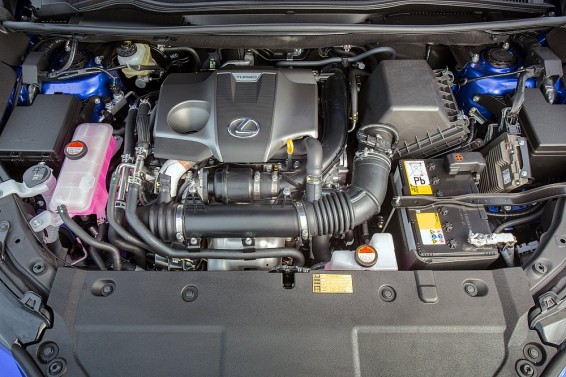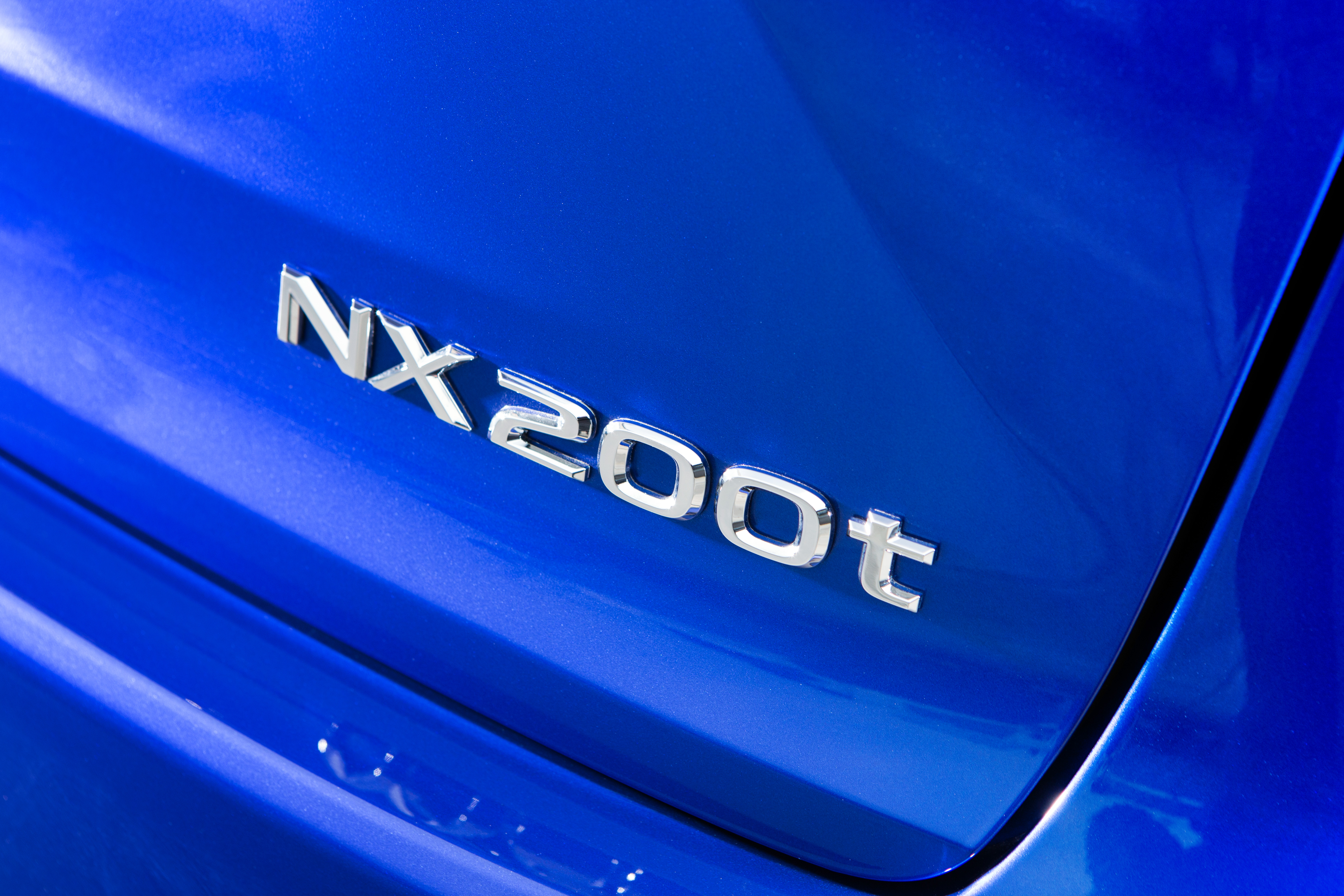The engine in the Lexus NX 200t is the first turbocharged direct-injection petrol engine to be developed in-house at Lexus and had the aim of achieving exciting performance with the best possible fuel efficiency.
The innovative 2.0-litre, in-line four-cylinder unit is the first in the world to combine a water-cooled cylinder head with an integral, four-into-two exhaust manifold and a twin-scroll turbocharger.
The engine meets Euro 6 emissions requirements. It generates maximum power of 235bhp (175kW) at 4,800 – 5,600rpm and 350Nm of torque from 1,650 to 4,000 rpm. This gives the NX 200t nought to 62mph acceleration in 7.1 seconds and a maximum speed of 124mph. Average fuel consumption for the NX 200t F Sport is 35.8mpg with 183g/km CO2 emissions.

World-first combination of engine technologies
Lexus has used a world-first combination of engine technologies to achieve a high level of responsiveness, minimal turbo lag and good low-speed torque, together with excellent fuel economy.
The four-into-two exhaust manifold pairs cylinders according to their expansion or compression stroke. This innovative structure acts in conjunction with the highly efficient twin-scroll turbocharger and prevents interference between the exhaust gases from each cylinder, generating high torque across the widest possible rev range.
The engine also uses an air-to-liquid intercooler mounted directly on the engine, significantly reducing the intake volume downstream of the turbo, so minimising turbo lag and securing highly responsive performance.
The twin-scroll turbocharger itself features variable wastegate valve control. This minimises pumping losses by reducing back pressure during low engine loads when the turbo isn’t required. This gives excellent fuel economy and also contributes to the engine meeting Euro 6 emissions standards.
Integrating the exhaust manifold within the cylinder head improves exhaust gas cooling without sacrificing the warm-up performance of the catalyst. This suppresses catalyst deterioration, but also expands driving range at the optimum, stoichiometric air-fuel ratio.
D-4ST fuel injection
The D-4ST fuel injection system combines direct fuel injection and turbocharging technology to create a high level of compatibility between the high tumble ratio (achieved by optimising the shape of the cylinder head intake ports), the piston tops and the turbo boost control.
D-4ST uses a high pressure fuel system for injection directly into the cylinders and a low pressure system for port injection. Injection is split between the direct and port injectors according to engine load, optimising fuel combustion in all driving situations to improve both low-speed torque and fuel economy.
Dual VVT-iW technology
The new Lexus turbo engine features innovative dual intelligent variable valve-timing technology – Dual VVT-iW. This allows torque to be optimised throughout the rev range and enables the engine to run at start-up on the Otto cycle, then switch to the more fuel-efficient Atkinson cycle. The system applies VVT-i to the exhaust valves and VVT-iW to the intake valves.
The late closing of the intake valve on the Atkinson cycle reduces pumping losses and boosts fuel economy. VVT-iW incorporates a mid-position lock which not only enables the Atkinson cycle to be maintained without sacrificing starting performance in cold weather, but also delivers wide open throttle performance.

Light weight and further advanced features
The engine is remarkably light and compact. It weighs just 160kg, being cast in a low nickel content heat-resistant steel and featuring a cylinder head cover, intake manifold and intake pipes formed in a resin material.
The aluminium alloy used for the cylinder head sub-assembly has superior heat-conducting properties. Weight has also been trimmed by reducing the number and thickness of parts. The unit underwent more than 10,000 hours of bench testing prior to covering more than a million kilometres in on-road trials.
A number of measures were taken to reduce friction losses in different parts of the engine, helping improve fuel economy. These include using an offset crankshaft to lower the piston thrust load; improved machining of the cylinder bore; and a surface treatment for the pistons which reduces slide resistance. Low-tension piston rings have been used and the weight of reciprocating parts has been reduced.

There is also a lightweight roller rocker valvetrain and a low-friction timing chain. Low-friction materials have also been used for the crankshaft oil seals, and the flow of lubricating oil has been optimised, with a variable discharge mechanism reducing the oil pump flow.
Careful heat management inside the engine further improves fuel efficiency: a rapid warm-up system for the cylinder block suppresses the flow of coolant into the block when the engine is cold, and a piston-cooling oil jet control system cuts the oil supply to the pistons to improve warm-up speeds.
Smoothness, quietness and turbo sound
With the rigidity of its main structural components already optimised to suppress vibration, the new engine is also equipped with a balance shaft with resin gears for even greater smoothness.
New, calcium-free lubricating oil helps prevent engine knock at low revs; the piston cooling oil jet system further improves anti-knock performance.
The water-cooled intercooler provides strong advantages in acceleration from standstill, and delivers a 0.3-second reduction in the 0-62mph acceleration time compared to an air-to-air unit. The acceleration curve prioritises torque delivery at low speeds.
Turbo engines tend to be noisy when the throttle is closed – the effect known as “turbo sigh”. Lexus has used an electric air bypass valve and resonator to greatly reduce the characteristic turbo noise. As a turbocharged engine requires a smooth intake flow for performance, Lexus’s engineers focused on creating special duct shapes that deliver power without noise.





The average fuel consumption is not 35.8mpg as stated. That is incorrect, please change. It is rated at 28 highway, 22 city. I get more like 18 city.
Hi Sean,
The consumption figures were obtained using a standardised EU mandated test, called NEDC. The test has now been changed to better replicate real world driving and is called WLTP.
Thanks
The 35.8mpg is incorrect.
Hi Mike,
The fuel consumption figures were obtained using the standardised NEDC test, legislated by the EU. A new test is now in place, which provides more realistic fuel consumption figures, called WLTP.
Thanks
I would like to try this vehicle
Hi Julius, thanks for getting in touch.
You can arrange a test drive here: https://www.lexus.co.uk/forms/test-drive
Thanks,
Lexus UK